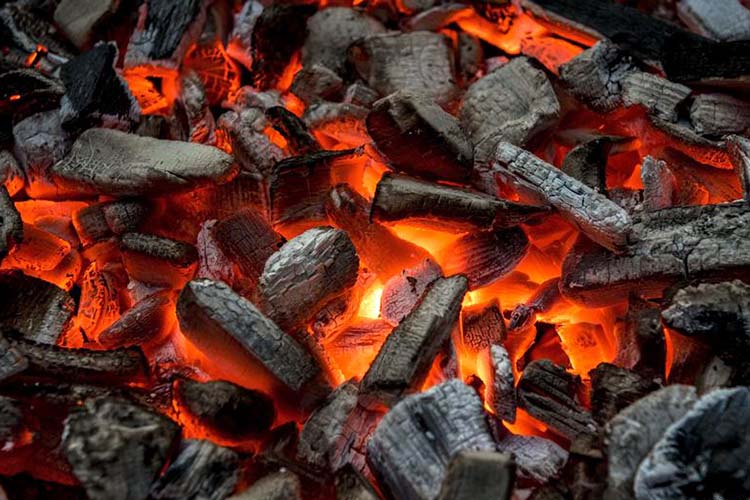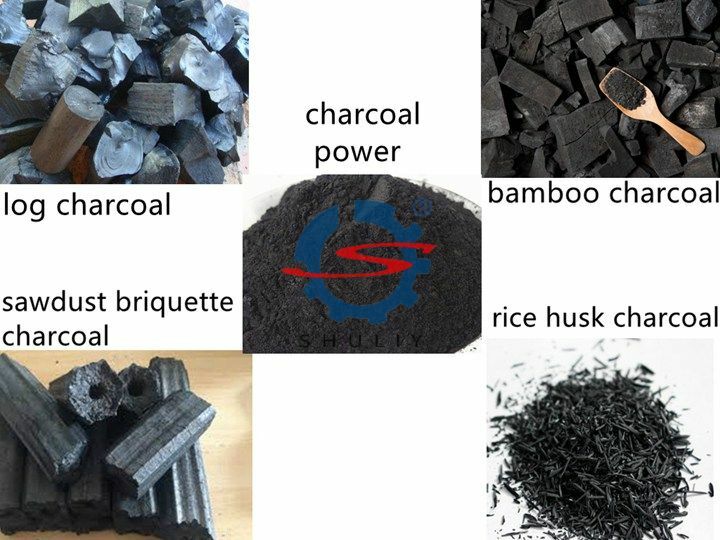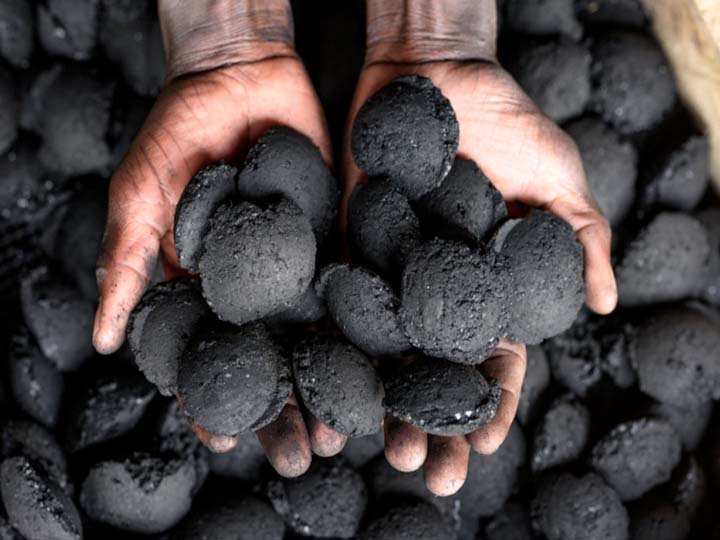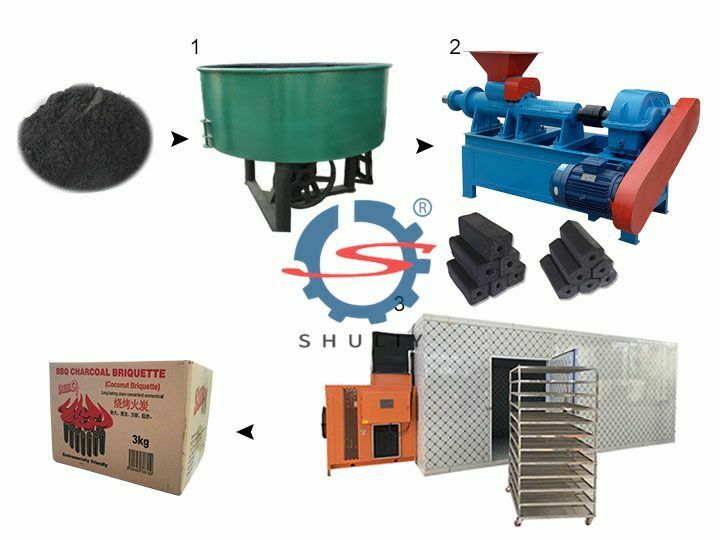Biomasse-Holzkohlebriketts: Eigenschaften, Vorteile und Verfahren
Biomasse-Holzkohle oder Biomassebriketts werden in vielen Entwicklungsländern weit verbreitet eingesetzt. Es handelt sich um eine Art nachhaltiger Brennstoffenergie, die aus biogenen Rohstoffen wie Kokosnussschalen, Sägemehl, Reishülsen, Palmkerne, Bambus, Abfallholz usw. hergestellt wird. Sie zeichnen sich durch vielseitige Verwendungsmöglichkeiten, niedrige Emissionen, hohe Energiedichte und so weiter aus. Was ist also Biomasse-Holzkohle? Wofür werden Biomassebriketts verwendet? Wie stellt man Biomasse-Holzkohle her? Hier sind die Antworten.

Was ist Biomassekohle?
Biomasse-Holzkohle ist ein festes Material, das durch Erhitzen von Biomasse wie Holz, Bambus oder landwirtschaftlichen Abfällen in Abwesenheit von Sauerstoff hergestellt wird. Dieser Prozess, der Karbonisierung genannt wird, wandelt die Biomasse in eine kohlenstoffähnliche Substanz um, die für verschiedene Zwecke verwendet werden kann. Die produzierte Holzkohle hat einen höheren Kohlenstoffgehalt als die ursprüngliche Biomasse, ist dichter, haltbarer und hat einen höheren Heizwert. Biomasse-Holzkohle kann als Brennstoff, in der Landwirtschaft, zur Wasserfiltration und in anderen industriellen Prozessen verwendet werden.
Es gilt als erneuerbare Energiequelle, da es aus erneuerbaren Materialien hergestellt wird, und gilt außerdem als CO2-negativ, was bedeutet, dass es mehr Kohlenstoff aus der Atmosphäre aufnehmen kann, als es bei der Produktion freisetzt.
Biomasse-Brikett-Rohstoff
Biomassebriketts sind eine Art fester Biobrennstoff, der aus komprimierten Biomasseabfällen wie Sägemehl, landwirtschaftlichen Rückständen, Holzspänen, Kokosnussschalen, Reisschalen und anderen ähnlichen Materialien hergestellt wird. Diese Rohstoffe werden gesammelt, verarbeitet und unter hohem Druck komprimiert, um eine dichte und langlebige Kraftstoffquelle zu bilden.
Zu den gängigen Rohstoffen zur Herstellung von Biomassebriketts gehören:
Holzspäne: Holzspäne sind ein Nebenprodukt der Holzverarbeitungsindustrie, wie z.B. Sägewerke und Möbelhersteller. Sie können zur Herstellung von Biomassebriketts verwendet werden, müssen jedoch zuerst getrocknet werden.
Sägemehl: Sägemehl ist ein weiteres gängiges Rohmaterial zur Herstellung von Biomassebriketts. Es ist ein Nebenprodukt der Holzverarbeitung und Möbelherstellung und kann entweder so verwendet oder mit anderen Materialien vermischt werden.
Landwirtschaftliche Abfälle: Landwirtschaftliche Abfälle wie Stroh, Reishülsen und Maiskolben können zur Herstellung von Biomassebriketts verwendet werden. Diese Materialien sind oft leicht verfügbar und kostengünstig, was sie zu einer guten Wahl für Kleinproduzenten macht.
Bagasse: Bagasse ist der faserige Rückstand, der nach der Gewinnung von Zuckerrohrsaft übrig bleibt. Es ist ein gängiges Rohmaterial zur Herstellung von Biomassebriketts in Zuckerrohr-produzierenden Ländern.
Dünger: Tierdünger wie Rinderdung und Geflügelabfälle können ebenfalls zur Herstellung von Biomassebriketts verwendet werden. Diese Materialien sind reich an organischer Substanz und können eine Brennstoffquelle für Kleinbauern darstellen.
Kommunale Abfälle: Kommunale feste Abfälle können ebenfalls zur Herstellung von Biomassebriketts verwendet werden. Dieser Prozess wird als Abfalltrennung und -recycling bezeichnet.
Die zur Herstellung von Biomassebriketts verwendeten Rohstoffe können je nach spezifischer Anwendung und Materialverfügbarkeit in einem bestimmten Gebiet variieren. Es ist wichtig zu beachten, dass die Rohstoffe vor der Verarbeitung zu Briketts ordnungsgemäß getrocknet und verarbeitet werden sollten, um sicherzustellen, dass das Endprodukt die gewünschte Dichte, Haltbarkeit und den gewünschten Energiegehalt aufweist.

Biomassebriketts vs. Kohle
Biomassebriketts und Kohle sind beides Formen fester Brennstoffe, die zur Erzeugung von Wärme und Strom genutzt werden können. Es gibt jedoch einige wesentliche Unterschiede zwischen den beiden.
Biomassebriketts werden aus komprimierten organischen Materialien wie Holzspänen, Sägemehl und landwirtschaftlichen Abfällen hergestellt. Sie sind eine erneuerbare Energiequelle, da die für ihre Herstellung verwendeten Materialien wieder aufgefüllt werden können. Biomassebriketts erzeugen bei der Verbrennung im Vergleich zu Kohle auch weniger Kohlenstoffemissionen und Feinstaub.
Kohle hingegen ist ein fossiler Brennstoff, der aus der Erde gewonnen wird. Es ist nicht erneuerbar und bei seiner Verbrennung werden Kohlendioxid, Schwefeldioxid und andere Schadstoffe in die Luft freigesetzt.
Obwohl sowohl Biomassebriketts als auch Kohle zur Erzeugung von Wärme und Strom verwendet werden können, sind Biomassebriketts insgesamt eine nachhaltigere und umweltfreundlichere Alternative zu Kohle.
Vorteile von Biomasse-Holzkohlebriketts
Die Verwendung von Biomasse-Holzkohlebriketts als Brennstoffquelle bietet mehrere Vorteile:
Erneuerbar und nachhaltig: Biomasse-Holzkohlebriketts werden aus komprimierten organischen Materialien wie Holzspänen, Sägemehl und landwirtschaftlichen Abfällen hergestellt, die erneuerbare Ressourcen sind, die wieder aufgefüllt werden können.
Verminderte Treibhausgasemissionen: Biomasse-Holzkohlebriketts erzeugen im Vergleich zu traditionellen fossilen Brennstoffen wie Kohle und Erdgas weniger Kohlenstoffemissionen.
Kosteneffektiv: Biomasse-Holzkohlebriketts sind oft günstiger als traditionelle fossile Brennstoffe und können lokal produziert werden, was die Transportkosten senkt.
Verbesserte Luftqualität in Innenräumen: Biomasse-Holzkohlebriketts produzieren weniger Feinstaub und Asche im Vergleich zu traditionellen Brennstoffen, was zu einer verbesserten Luftqualität in Innenräumen führt.
Vielseitigkeit: Biomasse-Holzkohlebriketts können für verschiedene Anwendungen wie Kochen, Heizen und Stromerzeugung verwendet werden.
Verminderte Abholzung: Biomasse-Holzkohlebriketts aus nachhaltigen Holzquellen können helfen, die Abholzung zu reduzieren und natürliche Wälder zu schützen.
Schaffung von Arbeitsplätzen: Die Produktion und Verteilung von Biomasse-Holzkohlebriketts kann Arbeitsplätze in ländlichen Gebieten schaffen und die wirtschaftliche Entwicklung fördern.

Wie stellt man Biomassekohle her?
Es gibt verschiedene Methoden zur Herstellung von Biomasse-Holzkohle, aber eine der gebräuchlichsten Methoden ist die Pyrolyse. Bei der Pyrolyse wird Biomasse wie Holz oder landwirtschaftliche Abfälle unter Abwesenheit von Sauerstoff erhitzt, um Holzkohle und andere Nebenprodukte zu erzeugen.
Hier sind die allgemeinen Schritte zur Herstellung von Biomassekohle mittels Pyrolyse:
Sammlung und Trocknung der Biomasse: Sammeln Sie die Biomasse, die Sie verwenden möchten, und trocknen Sie sie auf einen Feuchtigkeitsgehalt von weniger als 20%. Dies stellt sicher, dass die Biomasse während des Pyrolyseprozesses effizient verbrennt.
Hacken oder Mahlen der Biomasse: Hacken oder mahlen Sie die Biomasse in kleine Stücke, um die Oberfläche zu vergrößern und den Pyrolyseprozess zu beschleunigen.
Bauen oder kaufen Sie einen Pyrolyseofen: Sie können einen einfachen Pyrolyseofen aus einem Metallfass bauen oder einen fortschrittlicheren Ofen von einem Hersteller kaufen.
Laden Sie die Biomasse in den Ofen: Laden Sie die gehackte oder gemahlene Biomasse in den Pyrolyseofen.
Dichten Sie den Ofen ab und erhitzen Sie die Biomasse: Dichten Sie den Ofen ab und erhitzen Sie die Biomasse auf eine Temperatur zwischen 400 und 500 °C. Dies bewirkt, dass die Biomasse zerfällt und Gase freisetzt, wobei die Holzkohle zurückbleibt.
Lassen Sie die Holzkohle abkühlen: Lassen Sie die Holzkohle nach Abschluss des Pyrolyseprozesses abkühlen, bevor Sie sie aus dem Ofen nehmen.
Die Holzkohle zerkleinern: Zerkleinern Sie die Holzkohle gegebenenfalls in kleine Stücke, je nach Verwendungszweck.
Es ist erwähnenswert, dass die Herstellung von Holzkohle zu Hause oder im kleinen Maßstab aufgrund der hohen Brandgefahr und fehlender Sicherheitsmaßnahmen nicht zu empfehlen ist und durch den Prozess Schadstoffe in die Luft gelangen können.

Wofür werden Biomassebriketts verwendet?
Kochen: Biomassebriketts können als Brennstoffquelle zum Kochen in Haushalten, Restaurants und anderen lebensmittelbezogenen Unternehmen verwendet werden.
Heizen: Biomassebriketts können als Brennstoffquelle zum Heizen in Wohnungen, Gewerbegebäuden und Industrieanlagen verwendet werden.
Stromerzeugung: Biomassebriketts können zur Stromerzeugung in Kraftwerken verwendet werden und bieten eine erneuerbare Energiequelle.
Industrielle Prozesse: Biomassebriketts können als Brennstoffquelle in verschiedenen industriellen Prozessen wie Trocknung, Ofenfeuerung und Dampferzeugung verwendet werden.
Transport: Biomassebriketts können als Brennstoffquelle in Fahrzeugen wie Bussen und Lastwagen verwendet werden, wodurch die Abhängigkeit von fossilen Brennstoffen verringert wird.
Freizeitnutzung: Biomassebriketts können als Brennstoffquelle für Lagerfeuer und andere Freizeitaktivitäten verwendet werden.
Insgesamt bieten Biomassebriketts eine kostengünstige, nachhaltige und vielseitige Alternative zu herkömmlichen fossilen Brennstoffen für ein breites Anwendungsspektrum.
Abschluss
Biomasse-Holzkohlebriketts sind eine nachhaltige Energiequelle, die aus verschiedenen Biomasse-Materialien wie Holz, Sägemehl, Reishülsen, Kokosnussschalen, Stroh usw. hergestellt werden können. Biomasse-Holzkohle kann als Brennstoffquelle für BBQ, Shisha usw. verwendet werden. Wenn Sie Biomassebriketts effizient und zuverlässig herstellen möchten, ist eine Biomasse-Holzkohle-Produktionlinie erforderlich, die Biomasse-Materialien direkt in reguläre Holzkohlebriketts umwandeln kann. Zu den Hauptmaschinen gehören eine Karbonisierungsmaschine, eine Holzkohlemahlmaschine, eine Holzkohlebrikettmaschine, ein Holzkohle-Trockner und eine Holzkohle-Verpackungsmaschine.
Wir sind ein professioneller Hersteller von Holzkohlemaschinen und bieten eine vollständige Palette von Lösungen zur Herstellung von Holzkohlebriketts an. Möchten Sie Ihr Holzkohleherstellungsgeschäft starten? Kontaktieren Sie einen Experten für weitere nützliche Details.
